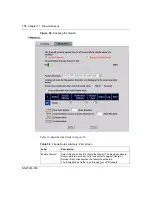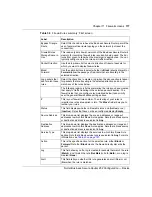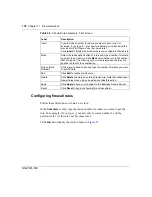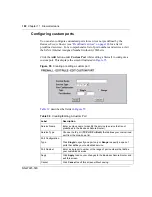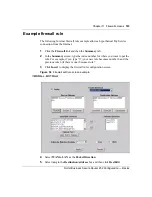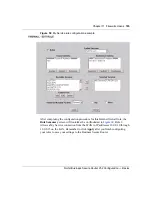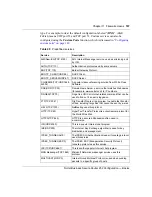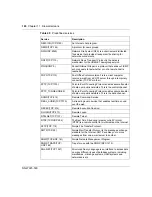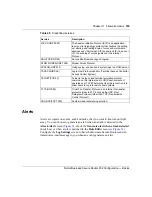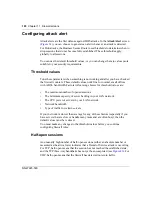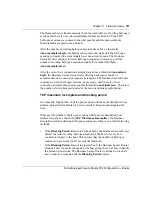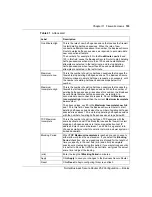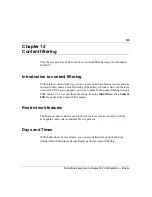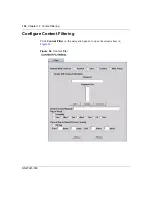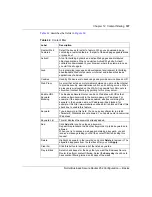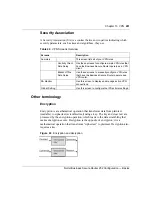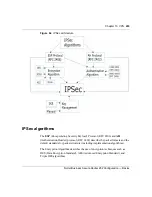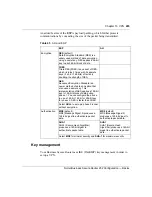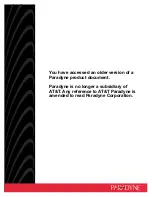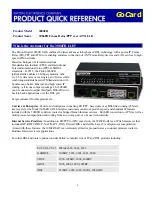
190
Chapter 11 Firewall screens
NN47923-500
Configuring attack alert
Attack alerts are the first defense against DOS attacks. In the
Attack Alert
screen
) you can choose to generate an alert whenever an attack is detected.
For DoS attacks, the Business Secure Router uses thresholds to determine when to
drop sessions that do not become fully established. These thresholds apply
globally to all sessions.
You can use the default threshold values, or you can change them to values more
suitable to your security requirements.
Threshold values
Tune these parameters when something is not working and after you have checked
the firewall counters. These default values work fine for normal, small offices
with ADSL bandwidth. Factors influencing choices for threshold values are:
•
The maximum number of opened sessions
•
The minimum capacity of server backlog in your LAN network
•
The CPU power of servers in your LAN network
•
Network bandwidth
•
Type of traffic for certain servers
If your network is slower than average for any of these factors (especially if you
have servers that are slow or handle many tasks and are often busy), then the
default values must be reduced.
You must make any changes to the threshold values before you continue
configuring firewall rules.
Half-open sessions
An unusually high number of half-open sessions (either an absolute number or
measured as the arrival rate) indicates that a Denial of Service attack is occurring.
For TCP, half-open means that the session has not reached the established state,
and the TCP three-way handshake has not yet been completed (see
UDP, half-open means that the firewall has detected no return traffic.
Summary of Contents for BSR252
Page 28: ...28 Tables NN47923 500 ...
Page 44: ...44 Chapter 1 Getting to know your Business Secure Router NN47923 500 ...
Page 52: ...52 Chapter 2 Introducing the WebGUI NN47923 500 ...
Page 70: ...70 Chapter 3 Wizard setup NN47923 500 ...
Page 96: ...96 Chapter 5 System screens NN47923 500 ...
Page 114: ...114 Chapter 7 WAN screens NN47923 500 Figure 27 WAN IP ...
Page 120: ...120 Chapter 7 WAN screens NN47923 500 Figure 31 Dial Backup Setup ...
Page 128: ...128 Chapter 7 WAN screens NN47923 500 ...
Page 152: ...152 Chapter 9 Static Route screens NN47923 500 ...
Page 194: ...194 Chapter 11 Firewall screens NN47923 500 ...
Page 210: ...210 Chapter 13 VPN NN47923 500 Figure 67 Summary IP Policies ...
Page 222: ...222 Chapter 13 VPN NN47923 500 Figure 71 VPN Branch Office rule setup ...
Page 256: ...256 Chapter 13 VPN NN47923 500 Figure 81 VPN Client Termination advanced ...
Page 260: ...260 Chapter 13 VPN NN47923 500 ...
Page 264: ...264 Chapter 14 Certificates NN47923 500 Figure 83 My Certificates ...
Page 270: ...270 Chapter 14 Certificates NN47923 500 Figure 85 My Certificate create ...
Page 274: ...274 Chapter 14 Certificates NN47923 500 Figure 86 My Certificate details ...
Page 282: ...282 Chapter 14 Certificates NN47923 500 Figure 89 Trusted CA details ...
Page 298: ...298 Chapter 14 Certificates NN47923 500 ...
Page 316: ...316 Chapter 16 IEEE 802 1x NN47923 500 ...
Page 320: ...320 Chapter 17 Authentication server NN47923 500 Figure 106 Local User database edit ...
Page 328: ...328 Chapter 17 Authentication server NN47923 500 ...
Page 376: ...376 Chapter 20 Logs Screens NN47923 500 Figure 150 Log settings ...
Page 386: ...386 Chapter 20 Logs Screens NN47923 500 ...
Page 393: ...Chapter 21 Call scheduling screens 393 Nortel Business Secure Router 252 Configuration Basics ...
Page 394: ...394 Chapter 21 Call scheduling screens NN47923 500 ...
Page 410: ...410 Chapter 22 Maintenance NN47923 500 ...

